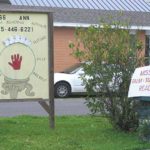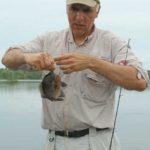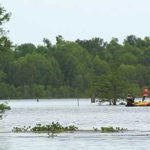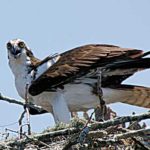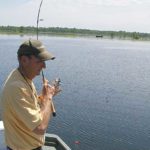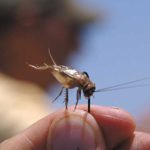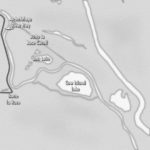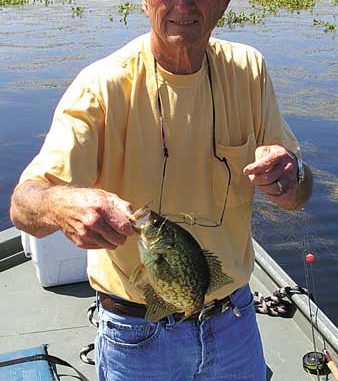
Head down to this Atchafalaya Basin hotspot, and you’ll spend much of the day looking down at your hand.
Maybe it was dense fog. Or maybe it was the moisture of the fog’s water droplets that dampened my jacket, where the breeze generated by the boat’s movement gave me a chill. Whatever it was, in my head playing like a CD was the Eagles’ Hotel California tune I found myself replacing the words to, with anything that related to the river.
Most guys forget the words anyway, including me, so it came sort of naturally.
“On a fog-laden river, cool wind in my hair…
“Warm misty fingers, rising up through the air…”
“Up ahead in the distance, I missed a fork by the way…”
“My head grew heavy and my sight grew dim…”
“We had to stop to get right…”
What could I say? It was a spiritual thing, what with all of the talk about bream that covered your palm. Palm readers. Fish so big they went halfway up your wrist, measured by the length of your hand. Not sideways using the 4-inch width method, like you would when measuring the height of a horse to its withers.
If they filled your hand like a coffee cup saucer, they were keepers. Now that was “palm reading” in my book.
Nothing against the spiritualists of the world, but really, how hard can it be? The length of certain wrinkle lines on the palm of your hand means certain things. So do the lips of a shellcracker or bluegill hitting the wrist joint line on my hands. They tell me something too — I just caught a pretty darn big bream.
“What are we stopping for?” I asked my good friend Danny Womack from Lafayette, who invited me to make a trip with him to Cow Island Lake east of Butte La Rose, which produces some monster bream.
He was perplexed, trying to make sense through the fog of our whereabouts on the river.
“John, did you see a fork in the river? I think we passed where I was supposed to turn off.”
I had never been to Cow Island Lake before, and really wasn’t paying a whole lot of attention, let alone looking for a fork.
“No man, I didn’t see any fork. When was the last time you were here?”
“When I was a young man, we used to camp out down here,” my friend said with a smile.
Since the 67-year-old Womack hadn’t been what I considered a young man for quite some time, I wondered if the lake was really there or was it some aberration from his past. Maybe I should have stopped at that palm-reading place on the way down to inquire what kind of trip we were going to have.
Newcomers to the region, unlike locals who are more familiar, will have to pay close attention when trying to locate the narrow entrance that allows access to Cow Island Lake — particularly during the early morning twilight period.
Additionally, when the river rises each spring, access into the lake isn’t usually a problem. However, at other times during the year, it may be too shallow for some watercraft, when the river falls.
By the time we got our bearings, the fog was lifting, and it was well after 8 a.m. when we entered the lake. I’m sure, like me, fishermen will immediately find themselves in a little piece of Atchafalaya Basin heaven at first glance. The lake, dotted here and there with cypress trees, many housing osprey nests, provides a picturesque scene for anglers to relax and enjoy while reeling in a few fish.
Fishing the lake for bream is a matter of keeping things very simple. Using crickets for bait is as simple as it gets.
One of the tricks for landing palm readers is getting the insects down to the right depth. It may take a few casts and several adjustments, but once that critter drops down to the right depth, you’re in for some real action.
That action comes in the form of utilizing ultralight tackle. Little, inexpensive combination rod-and-reel setups, like the Shakespeare Microspin Combo, are excellent for bream action on the lake. The feeling you get from a big bull bream bending over the 4-1/2 foot rod you’re holding — it might as well be a lunker-bass.
One of the drawbacks to the little combos is, typically, they come packed with 2- or 4-pound-test line. You’ll want to use the maximum weight the light tackle can handle — normally 6-pound-test.
Cow Island Lake is full, perhaps too full, of subaquatic vegetation in the form of hydrilla. Big bull bream dive deep into the grass, where the light 2- and 4-pound-test line just doesn’t hold up. Often, you have to drag several pounds of grass up from the bottom and undress the fish surrounded by it.
Area 6 Louisiana Department of Wildlife and Fisheries Biologist Jody David pointed out something needs to be done concerning the nuisance vegetation.
“It’s a pretty place, it really is,” David said. “It’s just so tough to get around right now. The hydrilla got in and spread so quickly. My plan is to jump in there, when the river pops up, and we’re going to try and do some aquatic herbicidal treatment. Fishing-wise, we’re happy with it, but down with the aquatics.”
Bluegills and redear sunfish are the most common cricket-eaters anglers will catch on Cow Island Lake. But they’ll also boat a few fat slabs and bass as well.
There are specialists who go into the lake preferring to target and jig strictly for sac-a-lait. Noticeably, they seldom toss back the big bull bream caught as a byproduct.
Using crickets doesn’t take a lot of special tackle either. A spring-stick float or 1-inch bobber combined with a No. 6 Aberdeen pan-fish hook and removable split-shot are all you need.
In some cases, the split-shot can be overdone causing reduced sensitivity and bream sucking the cricket off of your hook. Use only enough split-shot to where the spring-stick float sets upright in the water and where the bulb is sunk about halfway.
Throughout the thick mats of hydrilla, there are openings to toss or drop your rig into. Adjust your float, starting out approximately 3 to 3 1/2 feet above your hook and only deeper if it becomes necessary. A few twitches, along with a slow start-stop reel pattern, will entice big palm readers out from the shadows of the hydrilla.
With all fishing, you have to contend with a few small bait stealers. But Cow Island Lake has plenty of bull bream that will flat out whack your bait and make your float disappear, like Jaws pulling under a 55-gallon drum.
Once you’ve found a deep, dark hole in the hydrilla that’s producing, it’s not uncommon to pull several palm readers out of it. Plan to sit until the hole plays out, and then go find another. Competition on the lake is minimal. There are plenty of secluded pockets and holes in the grass to go around, and ample room for boaters to spread out on the lake.
For those who enjoy using artificial baits, old standbys like the 1/16- and 1/32-ounce Johnson Beetle Spin and Laker Critter Spin are effective along with standard crappie tube jigs.
Because the big bream are holed-up in the hydrilla, there isn’t a lot of long casting or flipping that you can do for them. Anglers will be limited to jigging the holes in the blankets of grass, but the reward can be loads of fun when utilizing the micro-lures.
During the morning, Womack and I got pretty good at palm reading. Kicked back and relaxed, the Eagles tune booted up in my head again.
“Welcome to the Atchafalaya Basin…”
“Cow Island Lake, such a lovely place…”
“Living it up at Cow Island Lake in the basin…”
“What a nice surprise, bring your alibis…”
When it comes to fishing bream, who needs a spiritual advisor when you can do your own “palm reading” on Cow Island Lake.

